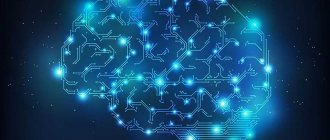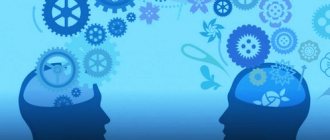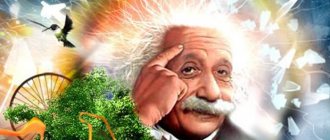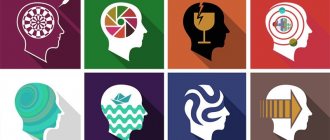Concept of thinking
Life constantly presents a person with tasks and problems of varying complexity.
The emergence of such problems, difficulties and surprises requires a person to have a deeper knowledge of the world, to discover new properties, patterns and connections in it. Each person makes many discoveries in his life, and these discoveries are not necessarily great and valuable on the scale of all humanity. Psychological research into the nature of thinking is based on the distinction between sensory and rational cognition. For human orientation in the natural and social world, sensory perception alone is not enough.
- Firstly, the essence of objects and phenomena does not directly coincide with their external appearance, accessible to perception.
- Secondly, complex phenomena of the natural and social world are inaccessible to perception; they are not expressed in visual properties.
- Thirdly, perception is limited to the reflection of objects and phenomena at the moment of their direct impact on the human senses; with the help of perception it is impossible to know what has already happened (the past) and what has not yet happened (the future).
Thinking reveals what is not directly given in perception. The main task of thinking is to identify essential, necessary connections based on real dependencies by separating them from random coincidences in time and space. In the process of thinking there is a transition from the individual to the general. Thus, thinking is characterized by a generalized reflection of reality.
In the process of thinking, the subject uses various kinds of means developed by humanity in order to penetrate into the essential connections and relationships of the objective and social world: practical actions, models, diagrams, symbols, signs, language, etc. Reliance on cultural means characterizes such a feature of thinking as its mediation.
Thus, traditional definitions of thinking, which can be found in most psychology textbooks, usually capture two of its characteristics: generalization and indirectness .
Thinking is the process of a generalized and indirect reflection of reality in its essential connections and relationships.
It is important to note two more features of thinking:
- Connection with action. S.L. Rubinstein wrote: “Thinking is closely connected with action. A person cognizes reality by influencing it, understands the world by changing it. Thinking is not simply accompanied by action, or action by thinking; action is the primary form of existence of thinking. The primary type of thinking is thinking in action and through action, thinking that occurs in action and is revealed through action”;
- Connection with speech. Human thinking is verbal thinking. Its formation occurs in the process of people communicating with each other. The formation of specifically human thinking in ontogenesis is possible only in the joint activity of an adult and a child.
Thinking as a higher mental function has four interrelated characteristics, each of which characterizes in its own way the role of speech in its development:
- Firstly, the actual human mental act is social, “divided” between people, which reflects the social nature of work activity, and for its implementation speech is necessary as a means of communication;
- Secondly, thinking arises as a process mediated first by material tools of labor, and then by a system of signs, including oral and written speech, i.e. means of consolidating and transmitting socio-historical experience;
- Thirdly, conceptual, logical thinking is arbitrary, speech acts as a system of means, mastering which a person can consciously control the thought process and organize joint mental activity;
- Fourthly, thinking as the highest mental function has a systemic structure, i.e. is built on the material of various natural processes (“manual” intelligence, involuntary attention, memory, imagination, etc.), and speech is the main “tool” with the help of which this system is organized and exists as a single mental formation.
Why does a person need imagination?
Imagination allows a person to move to another world, live a completely different life, feel like a completely different person who can do what this person cannot do in real life.
Interesting materials:
How to write capital Latin? How to write a receipt for no claims? How to write 1941 in Roman numerals? How to write a memo to your boss? How to write an SMS birthday invitation? How to write a Wikipedia article about yourself? How to write a clarification to the tax office? How to write to the labor inspectorate? How to write in Word on a photo? How to write to a private Instagram account?
Types of thinking
There are different types of thinking.
Visual-effective thinking is based on the direct perception of objects, the real transformation of the situation in the process of actions with objects.
Visual-figurative thinking is characterized by reliance on ideas and images. Its functions are related to the presentation of situations and changes in them that a person wants to achieve as a result of his activities that transform the situation. Its very important feature is the composition of unusual, incredible combinations of objects and their properties. In contrast to the visually effective, here the situation is transformed only in terms of the image.
Verbal-logical thinking is a type of thinking carried out using logical operations with concepts. It is formed over a long period (from 7-8 to 18-20 years) in the process of mastering concepts and logical operations during training.
There are also theoretical and practical , intuitive and analytical , productive and reproductive thinking.
Theoretical and practical thinking differ in the type of problems being solved and the resulting structural and dynamic features. Theoretical is the knowledge of laws and rules. An example of this is the discovery of the periodic table of elements by D. I. Mendeleev. The main task of practical thinking is to prepare a physical transformation of reality: setting a goal, creating a plan, project, scheme. One of its important features is that it is deployed under conditions of severe time pressure. Practical thinking provides very limited opportunities for testing hypotheses, all this makes it sometimes more complex than theoretical thinking. The latter is sometimes compared with empirical thinking. Here the criterion is the nature of the generalizations with which thinking deals; in one case, these are scientific concepts, and in the other, everyday, situational generalizations.
They also share intuitive and analytical (logical) thinking. In this case, they are usually based on three characteristics: temporal (time of the process), structural (division into stages), level of occurrence (awareness or unconsciousness). Analytical thinking unfolds in time, has clearly defined stages, and is represented in the human mind. Intuitive thinking is characterized by rapidity, the absence of clearly defined stages, and is minimally conscious.
It is important to distinguish between productive and reproductive thinking, based on the degree of novelty of the resulting result of mental activity.
Today, psychologists are convinced that creative thinking can be taught. To do this, it is necessary to develop the appropriate abilities involved in the process of creative thinking and overcome internal barriers to creativity. Typically, psychologists name four internal barriers to creativity.
- Conformity is the desire to be like others. People are afraid to express original ideas so as not to stand out from others. Their fears are most often associated with sad childhood experiences of misunderstanding and condemnation of their ideas among adults or peers.
- Rigidity is the difficulty of switching from one stereotypical point of view to another. Rigidity does not allow you to improve ready-made solutions, to “see” the unusual in the ordinary, familiar.
- The desire to find the answer immediately. It has been noted that the best solutions come during a “creative break,” when a person gives himself the opportunity to distract himself from persistently working on a problem and relax. If a person strives to solve the problem immediately at any cost, then the risk of a premature, ill-conceived solution is very high.
- Censorship is internal criticism of any one’s own idea. People with strict internal censorship prefer to wait for a natural solution to the problem or try to shift the responsible decision to someone else. Such lack of initiative usually develops in children whose parents adhere to an authoritarian parenting style and tend to criticize any actions of the child.
It is also necessary to isolate involuntary and voluntary thought processes: involuntary transformations of dream images and purposeful solution of mental problems.
Mental operations
The main mental operations are distinguished:
- analysis,
- comparison,
- synthesis,
- generalization
- abstraction , etc.
► Analysis is a mental operation of dividing a complex object into its constituent parts or characteristics.
► Comparison is a mental operation based on establishing similarities and differences between objects.
► Synthesis is a mental operation that allows one to mentally move from parts to the whole in a single process.
► Generalization is the mental unification of objects and phenomena according to their common and essential characteristics.
► Abstraction (distraction) is a mental operation based on highlighting the essential properties and connections of an object and abstracting from other, unimportant ones.
Features of the interaction between the processes of imagination and attention
Definition 1
The mental process of attention is understood as the direction and concentration of a person’s mental activity on any object or phenomenon.
The work of the attention process is closely related to the activity of all basic human cognitive processes - imagination, perception, thinking, memory.
The main objects of attention are both other people around a person and inanimate objects and objects. A person’s attention may also include natural phenomena, objects of art and science. It is necessary to note the fact that a person’s attention zone most often includes those objects and subjects that arouse his significant interest or there is a need for their mandatory study.
Forms of thinking
The main forms of logical thinking are concept, judgment, inference .
A concept is a form of thinking that reflects the essential properties, connections and relationships of objects and phenomena, expressed in a word or group of words.
Concepts can be general and individual , concrete and abstract .
In its development, thinking goes through two stages: pre-conceptual and conceptual.
During the normal development of a child, pre-conceptual thinking, the components of which are concrete images, is replaced by conceptual (abstract) thinking, which is characterized by concepts and formal operations. Conceptual thinking does not come immediately, but gradually, through a series of intermediate stages. Thus, L. S. Vygotsky identified 5 stages in the transition to the formation of concepts.
- The first is for a child 2-3 years old. When asked to put together similar objects that fit together, he puts any objects together, believing that those placed next to each other are suitable - such is the syncretism of children's thinking.
- The second stage is different in that children use elements of objective similarity between two objects, but the third object can be similar only to one of the first pair - a chain of pairwise similarities arises.
- The third stage occurs at the age of 7-10, when children can combine a group of objects by similarity, but are not able to recognize and name the features that characterize this group.
- And finally, in adolescents aged 11-14 years, conceptual thinking appears, but it is still imperfect, since primary concepts are formed on the basis of everyday experience and are not supported by scientific data.
- Perfect concepts are formed at the 5th stage, in adolescence, when the use of theoretical principles allows one to go beyond one’s own experience.
So, thinking develops from concrete images to perfect concepts, designated by words. The concept initially reflects the similar, unchangeable in phenomena and objects.
Another form of thinking is judgment.
Judgment is a form of thinking that reflects connections between objects and phenomena; affirmation or denial of something. Judgments can be true or false.
Inference is a form of thinking in which a definite conclusion is drawn based on several judgments. Inferences are distinguished between inductive, deductive, and analogical. Induction is a logical conclusion in the process of thinking from the particular to the general. Deduction is a logical conclusion in the process of thinking from the general to the specific. Analogy is a logical conclusion in the process of thinking from particular to particular (based on some elements of similarity).
Individual differences in the mental activity of people are associated with such qualities of thinking as breadth, depth and independence of thinking, flexibility of thought, speed and criticality of the mind .
Breadth of thinking is the ability to cover the entire issue, without at the same time missing the details necessary for the matter. Depth of thinking is expressed in the ability to penetrate into the essence of complex issues. The opposite quality is superficiality of judgment, when a person pays attention to little things and does not see the main thing.
Independence of thinking is characterized by a person’s ability to put forward new problems and find ways to solve them without resorting to the help of other people. Flexibility of thought is expressed in its freedom from the constraining influence of techniques and methods of solving problems fixed in the past, in the ability to quickly change actions when the situation changes.
Quickness of mind is a person’s ability to quickly understand a new situation, think and make the right decision,
Haste of the mind is manifested in the fact that a person, without thoroughly thinking through a question, picks out one side of it, rushes to make a decision, and expresses insufficiently thought-out answers and judgments.
A certain slowness of mental activity may be due to the type of nervous system - its low mobility, “The speed of mental processes is the fundamental basis of intellectual differences between people” (G. Eysenck).
Criticality of mind is a person’s ability to objectively evaluate his own and others’ thoughts, carefully and comprehensively check all put forward provisions and conclusions.
Individual characteristics include a person’s preference for a visual-effective, visual-figurative or abstract-logical type of thinking.
Along with perception, memory and thinking, imagination plays an important role in human activity. In the process of reflecting the surrounding world, a person, together with the perception of what is acting on him at the moment, or the visual representation of what influenced him before, creates new images.
► Imagination is the mental process of creating something new in the form of an image, idea or idea.
A person can mentally imagine something that he did not perceive or do in the past, he may have images of objects and phenomena that he has not encountered before. Imagination is unique to man and is a necessary condition for his work activity.
Being a necessary condition for human labor activity, it is always aimed at his practical activities. Before taking action, he imagines what should be done and how. Thus, a person creates in advance an image of a material thing that will be produced in practice. This ability of a person to imagine in advance the final result of his work, as well as the process of creating a material thing, sharply distinguishes human activity from the “activity” of animals, sometimes very skillful.
Imagination is always a certain departure from reality. But in any case, its source is objective reality.
Imagination plays a very important role in human life and activity. Among its many functions, the most significant are the following:
- goal setting and planning . The future result and the possibilities of achieving it are initially created in the imagination of the subject;
- educational _ Imagination carries out a mental retreat beyond the limits of what is directly perceived, constructs a concept about an object even before this concept itself is formed;
- activation of thought processes . Imagination allows you to use images in the thinking process.
- adaptive _ In the child’s psyche, a conflict arises between an excess of external information and a lack of means necessary to understand and explain the environment. Under these conditions, the child’s brain must certainly counteract the external flow of information falling upon it with a means that would allow it to recombine the source material and thus increase the volume of what is perceived, for example, fairy tales and myths;
- psychotherapeutic _ Why do children tell horror stories? This is a kind of protection against fears that appear in children at a certain stage of development.
Types of imagination.
There are several types of imagination, the main ones being passive and active . Passive , in turn, is divided into voluntary (daydreaming, daydreaming) and involuntary (hypnotic state, fantasy in dreams). Active imagination includes artistic, creative, critical, recreative and anticipatory .
Active imagination is always aimed at solving a creative or personal problem. A person operates with fragments, units of specific information in a certain area, combining them in various ways. Stimulation of such a process creates objective opportunities for the emergence of original new connections between the conditions recorded in the memory of a person and society. In an active imagination there is little daydreaming and “groundless” fantasy. It is connected with the future and operates with time as a well-defined category (that is, a person does not lose his sense of reality, does not place himself outside of temporary connections and circumstances). This imagination is directed more outward, a person is occupied with the environment, society, activity and, to a lesser extent, with internal subjective problems. Active imagination, finally, is awakened by a task and directed by it; it is determined by volitional efforts and is amenable to volitional control.
Recreating imagination is one of the types of active imagination, when the construction of new images and ideas occurs in accordance with stimulation perceived from the outside in the form of verbal messages, diagrams, conventional images, signs, etc. Despite the fact that its products are completely new, previously not perceived human images, it is based on previous experience.
Anticipatory imagination underlies a very important human ability: to anticipate future events, foresee the results of one’s actions, etc. Etymologically, foresee is closely related to the word “see,” which shows the importance of awareness of the situation and transferring certain of its elements into the future, which is based on knowledge or predicting the logic of events. Thanks to this ability, a person can “with his mind’s eye” see what will happen to him, to other people or to things around him in the future. F. Lersch called this the Promethean (looking forward) function of the imagination, which depends on the magnitude of life’s perspective: the younger the person, the stronger and brighter his imagination is oriented into the distance. In older and older people, the imagination is more connected with events of the past.
Creative imagination is a type of imagination when a person independently creates new images and ideas that are valuable to other people or society as a whole and which are embodied (“crystallized”) into specific original products of activity. Creative imagination is a necessary component and basis of all types of human creative activity. Its images are created through various intellectual operations. In the structure of creative imagination, two types are distinguished. With the help of the first, ideal images are formed, with the help of the second, finished products are processed.
One of the first psychologists to study these processes, T. Ribot, identified two main operations: dissociation and association .
Dissociation is a negative and preparatory operation during which sensory experience is fragmented. As a result of such preliminary processing of experience, its elements are able to give a new combination.
Without prior dissociation, creative imagination is unthinkable. This is its first stage, the stage of preparing the material. The inability to dissociate is a significant obstacle to creative imagination.
Association is the creation of a holistic image from its elements. It gives rise to new combinations, new images.
There are other intellectual operations, such as the ability to think by analogy with particular and purely accidental similarities.
Passive imagination is subject to internal, subjective factors. It obeys desires that seem fulfilled in fantasy. In the images of passive imagination, unsatisfied, mostly unconscious, needs of the individual are “satisfied”. All this is aimed at strengthening and preserving positively colored emotions and at repressing and reducing negative affects.
In the process of such passive imagination, an unreal, imaginary satisfaction of any need or desire is realized. This is the difference from realistic thinking, aimed at real, and not imaginary satisfaction of needs,
The materials of passive imagination, like active imagination, are images, ideas, elements of concepts and other information gleaned from experience.
Based on the nature of performance, the following are distinguished:
• reproducing imagination - the products of which were already known earlier.
• creative imagination.
According to the qualitative features determined by specific areas of application, T. A. Ribot gives the following types of imagination:
• plastic - it uses images and their connections indicated in space, corresponding to the actual relationship of objects, has an external character;
• vague - it uses emotional images that do not have definite outlines in space (imagination in music.
• mystical - it uses symbols; mysticism transforms natural images into symbolic ones, striving to embody the ideal in the forms of external nature;
• scientific - saturated with scientific thinking (in sciences that are just being built, it acts as scientific mythology; in sciences that have developed, it revives logical schemes);
Characteristics of imagination
Imagination is a special form of human life, standing apart from other technical processes and at the same time occupying an intermediate position between perception, thinking and memory.
Imagination is a special form of reflection, which consists of creating new images and ideas by processing existing ideas and concepts. Imagination develops along the lines of improving the operations of replacing real objects with imaginary ones and recreating imagination. The child gradually begins to create more and more complex images and their systems based on available descriptions and texts. The content of these images develops and enriches. Imagination becomes mediated and intentional.
In human life, imagination performs a number of specific functions. A.S. Vygotsky identifies three functions of imagination [Vygotsky L.S. Selected psychological studies - M., 1966]:
- Consistent. In order to evoke in a child a vivid idea of an object, it is necessary to find all the elements from which this idea will be built in real life.
- emotional. Each emotion has its own internal and external state, which means that fantasy is the apparatus that directly carries out the work of our emotions.
- Educational. In the game, the emotional function allows you to organize such forms of the environment that allow you to develop and realize your abilities. It can be seen that all the functions of the imagination are fully consistent with its psychological property - behavior aimed at forms that have not yet existed in our activity, and this emphasizes the need for the development of imagination.
Imagination is characteristically associated with the activity of the whole organism, being at the same time the most “mental” of all mental processes and states. It is nothing other than imagination that reveals the ideal and mysterious nature of the psyche. Thanks to imagination, a person creates, intelligently plans and manages his activities. Almost all of man's material and spiritual culture is a product of his imagination and creativity. Imagination takes a person beyond his immediate existence, reminds him of the past, and opens up the future. Possessing a rich imagination, a person can “live” in different times.
Imagination is the mental process of creating images of objects and situations by bringing a person’s existing knowledge into a new combination.
Thanks to imagination, a person creates, intelligently plans and manages his activities. Almost all of humanity's material and spiritual culture is a product of people's imagination and creativity. Imagination takes a person beyond his immediate existence, reminds him of the past, and opens up the future. Possessing a rich imagination, a person can “live” in different times, which no living creature in the world can afford.
Imagination differs from perception in that images do not always correspond to reality; they contain elements of fantasy, if the imagination draws pictures to the consciousness that nothing or little corresponds to. In reality this is called fantasy. If, in addition, the imagination is directed towards the future, then this is called a dream.
Imagination can be: involuntary or passive: dreams, day dreams, hallucinations (auditory and visual); voluntary or active imagination: recreative or reproductive and creative, musical. Creativity includes dreams and fantasies.
Active imagination is characterized by the fact that, using it, a person, at his own request, by force of will, evokes appropriate images. Active imagination includes creative and musical imagination.
Creative imagination is a type of imagination in which a person independently creates new images and ideas that have value for other people or society as a whole and are embodied (“crystallized”) in specific original products of activity. Images of creative imagination are created using various techniques and intellectual operations. In the structure of creative imagination, there are two types of such intellectual operations:
1st type of operations through which ideal images are formed;
2nd type of operations, on the basis of which finished products are processed
Ways to build new images
The transformation of reality in the imagination is carried out by methods; called "techniques" of imagination . These include:
Combination , the combination of data in the experience of elements in new, more or less unusual combinations. This is the simplest technique of imagination, and it is what researchers of the past had in mind when they considered associations to be the mechanism of imagination.
Agglutination, a combination option in which a non-random set of traits is subject to combination, undergoes a direct selection of them according to a specific plan, concept.
Accentuation , emphasizing certain features of a phenomenon, which transforms its overall appearance. It should highlight the characteristic, essential, important.
Hyperbole and litotes - Changes in magnitude, quantitative growth and decrease - are special options for emphasis (very large or very small in relation to reality are emphasized. When in the imagination there is immediately an increase in some sides and a decrease in others, we are talking about polarization.
Idealization , The construction of idealized images free from all petty things, which sometimes cause the illusion of exclusivity and perfection of a certain phenomenon. The main essence of dreams lies in the pursuit of ideal.
Typification , Specific generalization. Through the concrete in the image that appears to the type, the generally significant is highlighted.
Alegorization, Creation of allegory - the use of an image in a figurative sense. An image acts only as a conventionally chosen sign of some phenomenon of reality.
Metaphorization , Construction of metaphors. A metaphor is a deeper mental representation of a phenomenon than an allegory, since there is a certain similarity and analogy between the metaphorical image and its meaning.
Symbolization , the use of symbols, is the most profound, essential filling of the imagination technique. Understanding the language of symbols helps a person consciously receive messages from his own unconscious (dreams, etc.). A symbol differs from a sign in that it is not conventionally chosen to designate, but is deeply, essentially united with what it denotes. Unlike a concept, a symbol has an unlimited amount of meaning. Only the universal, due to the very way of human existence, can be expressed through symbols.
In the technique of imagination, a complex dynamic unity of the conscious and unconscious is always created.







